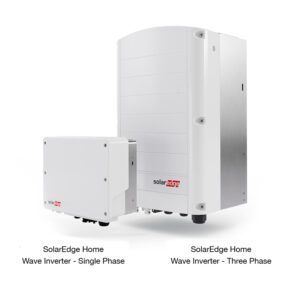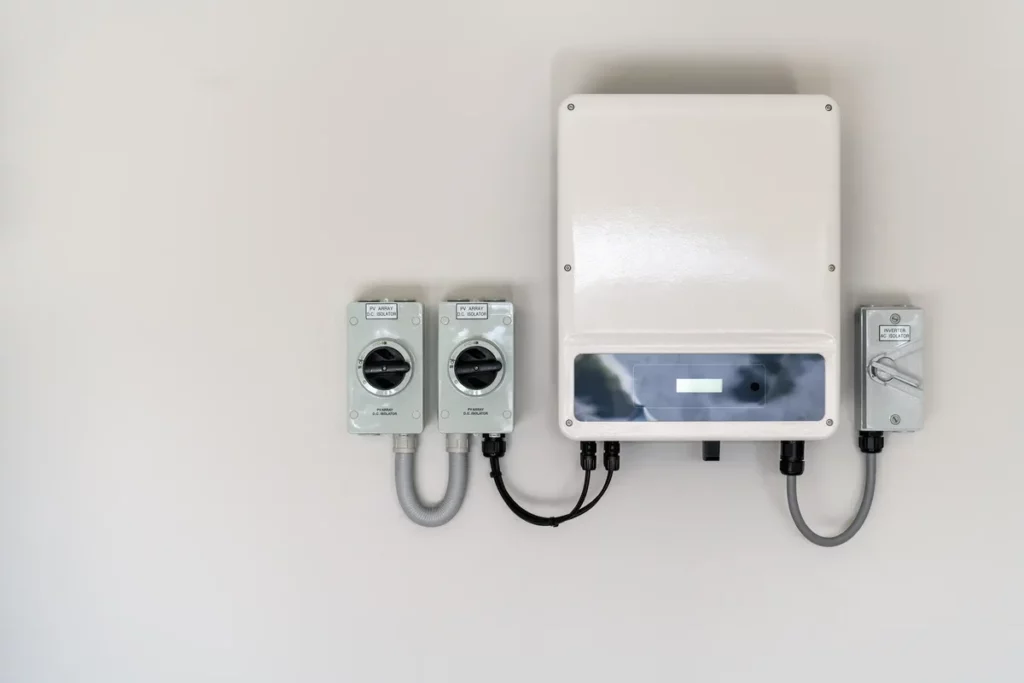Upon examining numerous solar inverters currently available, the SolarEdge Home Wave Inverter stood out as our top pick.
It distinguished itself as the most efficient among the options we evaluated, ensuring that you get the most out of the energy generated by your solar panels.
Furthermore, SolarEdge provides a strong warranty for this inverter, and its accompanying app has garnered positive feedback from users, adding to its appeal.

Tesla Solar Inverter
The Tesla Solar Inverter, designed for grid-tied systems, comes in two variants: a 3.8 kW model and a 7.6 kW model. Notably, it offers one of the most extended limited warranties in its category, lasting for 12.5 years.
This warranty duration stands out compared to other string inverters in the market.
In terms of efficiency, the Tesla Solar Inverter impresses with a peak efficiency of 98.60% and a California Energy Commission (CEC) efficiency rating of 98%.
These high-efficiency ratings indicate its effectiveness in converting solar energy into usable electricity.
Regarding user experience, the Tesla app, which is used for monitoring and managing the inverter, has received decent reviews.
While not flawless, its user scores are generally higher than many other inverter apps, indicating a relatively positive user experience.
Price-wise, the Tesla Solar Inverter is competitively positioned, often being more affordable than other string inverter options available.
This combination of high efficiency, a robust warranty, positive app reviews, and competitive pricing makes the Tesla Solar Inverter an attractive choice for those considering a grid-tied solar power system.

SolarEdge Home Wave Inverters
The SolarEdge Home Wave Inverter is an advanced grid-tied string inverter that caters to a variety of needs with its range of sizes, from 3.8 kW up to 11 kW.
This inverter stands out in the market, particularly due to its exceptional efficiency ratings.
With a peak efficiency of 99.20% and a California Energy Commission (CEC) efficiency rating of 99%, the SolarEdge Home Wave Inverter ranks at the top in terms of efficiency among the inverters reviewed.
These high ratings indicate that it converts almost all of the solar energy it receives into usable electricity, minimizing energy loss.
In addition to its impressive efficiency, the SolarEdge inverter boasts strong user satisfaction regarding its accompanying app.
The app has garnered the highest user review scores among inverter apps, reflecting its ease of use and effective functionality.
The inverter comes with a 12-year limited warranty, which is a strong commitment to its longevity and reliability.
Furthermore, SolarEdge offers the option to extend this warranty to either 20 or 25 years for an additional cost, providing further peace of mind and investment protection.
Overall, the SolarEdge Home Wave Inverter’s combination of high efficiency, strong user app reviews, and a robust warranty option makes it an excellent choice for those looking for a high-performing, grid-tied string inverter.

Enphase IQ8 Microinverters
Enphase offers a versatile range of six IQ8 microinverter models.
These units are uniquely grid-agnostic, which means they not only function as grid-tied systems but can also power your home during an outage without requiring a battery – though the right setup is necessary for this feature.
Each of these microinverters comes with an impressive 25-year warranty, providing long-term assurance of their performance and durability.
In terms of efficiency, the IQ8 microinverters boast a peak efficiency range between 97.4% and 97.6%, and a California Energy Commission (CEC) efficiency rating that varies from 97% to 97.5%.
These high-efficiency ratings indicate their effectiveness in converting solar energy into usable electricity.
The Enphase app, known as Enphase Enlighten, which is used for monitoring and managing the system, has received generally favorable reviews from users.
This positive feedback reflects well on the app’s functionality and user experience.
Overall, the Enphase IQ8 series stands out for its flexibility, high efficiency, extensive warranty, and positive user feedback on its monitoring app, making it a strong contender in the microinverter market.
Which Type of Solar Inverter Should You Choose?
Depending on factors like roof slope, shading, and orientation, the most suitable inverter type can vary significantly.
Homeowners generally have three main options: string inverters, string inverters with DC power optimizers, or microinverters, each with their own set of advantages and drawbacks.
String inverters connect a series of solar panels to one inverter.
However, if one panel in the string is shaded or malfunctioning, it can impact the entire string’s efficiency.
To mitigate this, homeowners often pair DC power optimizers with string inverters, enhancing individual panel performance.
String inverters, typically more affordable than microinverters, require additional costs if paired with DC power optimizers.
They are easier to maintain and replace as they are usually wall-mounted.
Microinverters, installed on each solar panel, offer a different setup.
They are particularly beneficial for complex roof setups or partially shaded roofs and allow for easier expansion of the solar system.
With longer warranty periods, microinverters are a robust option but are more challenging and costly to repair and replace due to their rooftop location.
How We Evaluated the Best Solar Inverters
Selecting the right solar inverter is a nuanced process, as not every inverter suits every home.
Solar energy solutions are highly site-specific and require a personalized approach, making it challenging to pinpoint the “best” inverter without an on-site consultation.
For our evaluation, we focused exclusively on single-phase, residential-use inverters listed in the California Energy Commission’s Solar Equipment Lists Program, without conducting any hands-on testing.
Our method for identifying the top solar inverters involved an objective assessment based on several key criteria.
We began by defining the categories for evaluation and assigning a weight to each, reflecting their perceived importance to the average consumer.
This decision was informed by extensive research and consultations with subject matter experts, who, however, did not directly influence our final selections.
The evaluation categories and their respective weights were as follows:
- Warranty: 25%
- California Energy Commission efficiency: 25%
- Peak/maximum efficiency: 10%
- User interface/consumer app: 15%
- Inverter size options: 10%
- Price: 5%
- Company reputation: 10%
We analyzed 10 of the most popular inverter brands, gathering data for each category.
Each inverter was then rated on a tier-style system (from 1 to 5) across these categories.
This rating helped us determine which inverters were above average, average, or below average in each aspect, based on our list.
This structured approach enabled us to compare the inverters fairly and identify which ones stood out in the competitive market.
How to Choose the Best Solar Inverter for Your Home?
To choose the best solar inverter, you need to understand your energy needs by analyzing your current electricity consumption.
This will help you determine the right size and capacity of the inverter.
It’s essential to match the inverter’s capacity with your solar panel system’s output to ensure optimal performance.
Next, consider the type of inverter that best suits your setup.
If your home experiences varying levels of sunlight due to shading, microinverters or power optimizers might be ideal as they optimize power output for each panel individually.
However, for a more straightforward roof setup without shading, a string inverter could be more cost-effective.
Efficiency is another critical factor. Look for inverters with high-efficiency ratings to ensure maximum conversion of solar power into usable electricity.
Also, consider the inverter’s durability and the manufacturer’s warranty, as these aspects can affect the long-term reliability of your system.








